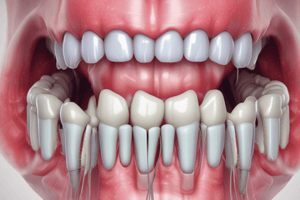Podcast
Questions and Answers
The embrasure that is located between the labial/buccal surfaces of adjacent teeth is called:
The embrasure that is located between the labial/buccal surfaces of adjacent teeth is called:
- Incisal embrasure
- Labial embrasure (correct)
- Occlusal embrasure
- Lingual embrasure
What is the primary function of embrasures in tooth morphology?
What is the primary function of embrasures in tooth morphology?
- To strengthen the interdental papillae
- To increase the occlusal table surface area
- To provide additional space for interproximal contacts
- To facilitate proper food escape and self-cleansing (correct)
Which statement about the height of contour on anterior teeth is correct?
Which statement about the height of contour on anterior teeth is correct?
- The height of contour on lingual surfaces is located in the cervical third
- The height of contour on both labial and lingual surfaces is located in the incisal third
- The height of contour on labial surfaces is located in the middle third
- The height of contour on both labial and lingual surfaces is located in the cervical third (correct)
What is the location of the height of contour on the lingual surface of mandibular second premolars?
What is the location of the height of contour on the lingual surface of mandibular second premolars?
Which statement regarding the curvatures on the lingual surfaces of mandibular posterior teeth is correct?
Which statement regarding the curvatures on the lingual surfaces of mandibular posterior teeth is correct?
What is the primary purpose of embrasures in reducing forces on teeth?
What is the primary purpose of embrasures in reducing forces on teeth?
Which embrasure is located between the incisal edges of adjacent anterior teeth?
Which embrasure is located between the incisal edges of adjacent anterior teeth?
How do embrasures contribute to the self-cleansing ability of teeth?
How do embrasures contribute to the self-cleansing ability of teeth?
Which statement about the cervical embrasure is correct?
Which statement about the cervical embrasure is correct?
How do embrasures protect the gingival tissues?
How do embrasures protect the gingival tissues?
Flashcards are hidden until you start studying
Study Notes
Rhomboid Outline Form of the Crown
- The rhomboid outline form of the crown in mandibular posterior teeth is due to the lingual inclination of the long axis of the crown to the axis of the root.
- The acute angles of the rhomboid form point towards the occlusolingual and buccocervical line angles.
- Significance of the rhomboid outline form:
- Proper occlusion
- Establishment of intercusp relation between opposing teeth
- Prevention of traumatic occlusion and its periodontium degenerative sequela
- Prevention of lips and cheeks being clipped during mastication
- Keeping the axis of roots of mandibular and maxillary teeth parallel
Trapezoid Outline Form of the Crown
- Facial and lingual crown outline of all teeth can be trapezoids of various dimensions.
- The shortest side of the trapezoid is towards the tooth cervix, while the longest side is towards the occlusal or incisal aspect.
- Significance of the trapezoid outline form:
- Provides contact between teeth at certain areas
- Provides interproximal spaces
- Provides spacing between roots of neighboring teeth
- Provides offset relation between teeth
Proximal Crown Outline of Anterior Teeth
- The proximal crown outline of anterior teeth is triangular in form.
- The base of the triangle is towards the cervix, while its apex is towards the incisal ridge.
- Embrasures are determined by the location of the contact area and can be classified into:
- Labial embrasure
- Buccal embrasure
- Lingual embrasure
- Incisal and occlusal embrasure
- Significance of embrasures:
- Acts as a spillway for the escape of food
- Decreases the occlusal table, reducing forces on teeth
- Allows for self-cleansing of teeth due to rounded, smooth surfaces
- Protects gingival tissues from undue frictional trauma
Facial and Lingual Contour
- The height of contour on both labial and lingual surfaces of all anterior teeth is located in the cervical third.
- The height of contour of the buccal surfaces of posterior teeth is located in the cervical third.
- The height of contour on the lingual surface of posterior teeth is located at the middle third, except for the lower 2nd premolar, which is located at the occlusal third.
- The curvatures on the lingual surfaces of mandibular posterior teeth are about 1 mm.
Studying That Suits You
Use AI to generate personalized quizzes and flashcards to suit your learning preferences.




